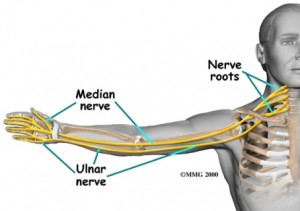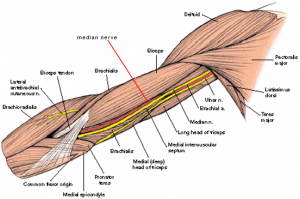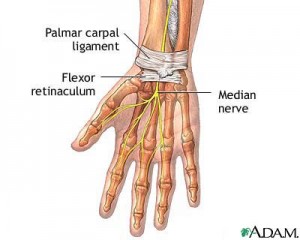The median nerve is affected when you suffer from carpal tunnel syndrome.
The carpal tunnel is a series of seven bones in the wrist, in two rows of three and four, that create a passageway for the median nerve and several tendons.
Carpal tunnel syndrome is a condition felt as pain in the palm and the inner hand— usually the thumb, index, and middle finger.
Yesterday’s post referred to wrist stretches and carpal tunnel syndrome, and almost all diagnoses of carpal tunnel syndrome focus on compression of the median nerve as it passes through the carpal tunnel along with several tendons.
But it is important to understand that the median nerve is part of the brachial plexus there is plenty of opportunity for trouble to begin long before the nerve reaches the hand.
To reiterate a previous post on the brachial plexus, forward head posture and tight or imbalanced muscles can contribute to nerve compression in the neck, sometimes leading to carpal tunnel syndrome.
For good measure, I’ll add a tight psoas into the mix because isn’t everything related to a tight psoas? One of the classic manifestations of a tight psoas has one shoulder pulled forward and down.
This pattern affects the pathway of the median nerve as the forward rolling shoulder pulls on the collar bone, slightly above the actual beginning of the median nerve, and affects the teres major where the median nerve enters the arm.
After the median nerve enters the arm near teres major, it passes between the biceps and the brachialis before moving down and passing between the super tight muscles I referenced yesterday—flexor digitorum superficialis, flexor digitorum profundus and flexor pollisis longus.
These muscles can all affect the median nerve before it reaches the carpal tunnel and though I am a proponent of stretching these muscles to help with carpal tunnel syndrome, finding relief from issues with the median nerve will also have to involve changes to the alignment of the head neck and shoulders as well.
Though sometimes issues with the median nerve and carpal tunnel syndrome can be alleviated simply by dealing with the area of the wrist it has long been my experience that most injuries are, more often than not, best dealt with by focusing away from the primary source of pain.
***




